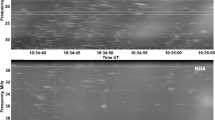Abstract
We present for the first time a set of intensity-time records for one solar type IIId radio burst with an echo component obtained as a result of angular selection of the radiation observed using an UTR 2 antenna operating in the mode of a two-dimensional heliograph at f=25 MHz. It is found that in the case of such events, which occur only in the central sector of heliolongitudes |l|≤50°, the apparent pulsating source of narrow-band (∼0.1 MHz) radiation at the second harmonic (f≈2fp) can have a complex, constantly varying angular structure. The coronal source positions determined at the time of the main peak of a two-hump burst and 6.5 s later at the time of its second, relatively low, maximum did not coincide and their divergence was ≈12′ in hour angle and ≈0′ in declination. During the first pulse (having a steep front) the source did not remain immobile and travelled for 3 s, gradually decaying, predominantly to the west at an average velocity close to the velocity of light. The amazing fact of initial nonstationarity and other properties of the pulsing type IIId source show that a fast imaginary source occurred in the solar corona at the site of short-time (< 1 s) radio wave generation, i.e., well above the normal level of plasma frequency\(\bar f_p {\text{ = }}f\). The background of the source was obviously an extended opaque or translucent region of disturbed plasma. Operating as a passive retranslator of signals, at the plasma levels fp∼f/2 this strange coronal structure could prevent the radio waves, including those reflected specularly at the plasma level\(\bar f_p {\text{ = }}f\) deep in the corona, from propagating freely. Most probably, this is exactly the reason why the decay of the echo component is slow and nonmonotonic in the case of type IIId bursts, many of which pulsate rhythmically 3 or 4 times.
Similar content being viewed by others
References
E. P. Abranin, L. L. Bazelyan, V. V. Zaitsev, et al.,Sol. Phys.,78, 179 (1982).
E. P. Abranin, L. L. Bazelyan, V. V. Zaitsev, et al.,Sol. Phys.,91, 383 (1984).
Ya. G. Tsybko,Sol. Phys.,92, 299 (1984).
E. P. Abranin, L. L. Bazelyan, and Ya. G. Tsybko,Astron. Zh.,73, 939 (1996).
A. C. Riddle,Sol. Phys.,35, 153 (1974).
S. Ya. Braude, A. V. Men’, and L. G. Sodin,Antenny,26, 3 (1978).
E. P. Abranin, L. L. Bazelyan, N. Yu. Goncharov, et al.,Sol. Phys.,66, 393 (1980).
E. P. Abranin, L. L. Bazelyan, and Ya. G. Tsybko,Astron. Zh.,67, 141 (1990).
Ya. G. Tsybko,Astron. Zh.,67, 420 (1990).
Ya. G. Tsybko,Astron. Zh.,69, 383 (1992).
E. P. Abranin, L. L. Bazelyan, and Ya. G. Tsybko, in: Abstracts of XXVth Radioastron. Conf., Pushchino (1993), p. 131.
E. P. Abranin, L. L. Bazelyan, and Ya. G. Tsybko,Izv. Vyssh. Uchebn. Zaved., Radiofiz.,40, No. 9, 1073 (1997).
Additional information
Radioastronomical Institute, Kharkov, Ukraine; Radiophysical Research Institute, Nizhny Novgorod, Russia. Translated from Izvestiya Vysshikh Uchebnykh Zavedenii, Radiofizika, Vol. 41, No. 1, pp. 105–120, January, 1998.
Rights and permissions
About this article
Cite this article
Abranin, E.P., Bazelyan, L.L. & Tsybko, Y.G. Preliminary data on decameter type IIId bursts with echo components obtained from a two-dimensional radio heliograph. Radiophys Quantum Electron 41, 68–77 (1998). https://doi.org/10.1007/BF02676713
Received:
Issue Date:
DOI: https://doi.org/10.1007/BF02676713




